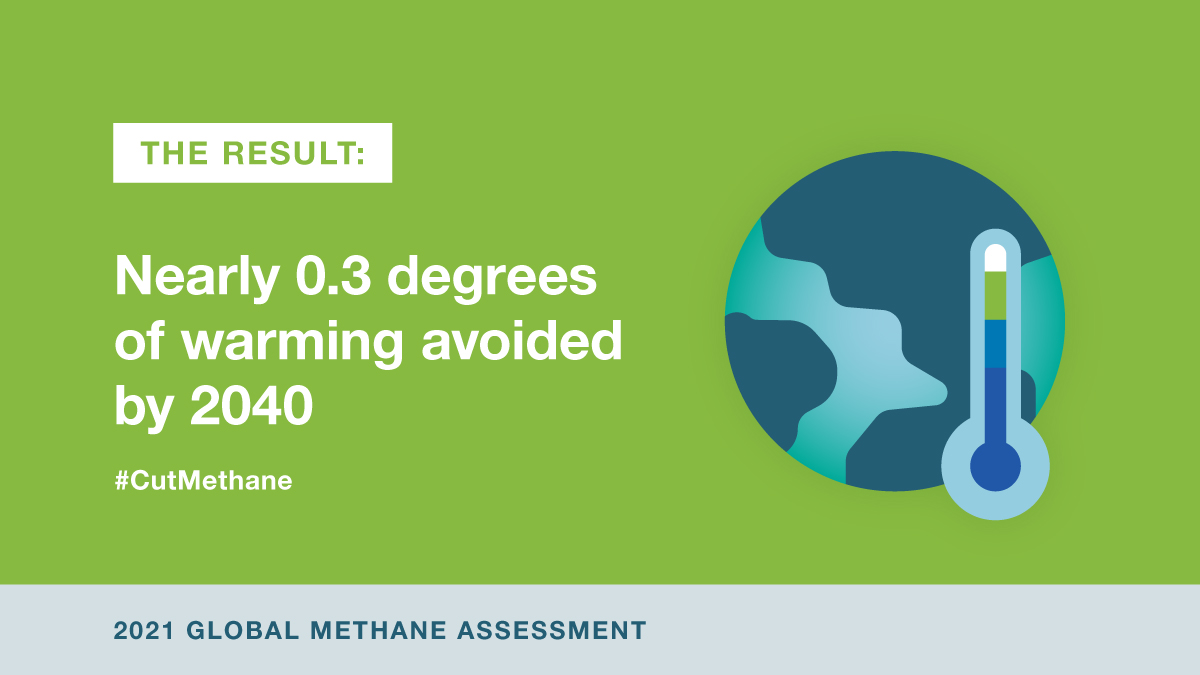Cutting Methane Key to Keeping Earth From Warming Itself Beyond Human Control

Avoids nearly 0.3°C by 2040, more by end of century
Aggressively cutting methane emissions is the fastest and most effective way to reduce the rate of warming and keep the global average temperature from breaching the 1.5°C barrier above preindustrial levels, according to the Global Methane Assessment released today by the UN Environment Program (UNEP) and the Climate and Clean Air Coalition (CCAC).
The Assessment calculates that available mitigation measures can cut emissions from human activities by 45 percent and avoid nearly 0.3 °C of warming by the 2040s, as well as avoid 255,000 premature deaths and 26 million tonnes of crop losses worldwide every year.
The Global Methane Assessment supports fast climate action to win the 10-year climate sprint to 2030 and limit warming to 1.5 °C. President Biden and his climate team made this a central part of the Climate Summit on Earth Day two weeks ago. At the Summit several heads of State including, President Macron of France, President Putin of Russia, President Phuc of Vietnam, and President Fernández of Argentina, called for fast methane mitigation.
“Cutting methane is the fastest way we know to slow warming,” said Durwood Zaelke, President of the Institute for Governance & Sustainable Development. “This makes methane mitigation the best strategy for slowing self-reinforcing feedbacks and avoiding dangerous climate tipping points, including the loss of the reflective sea ice in the Arctic.”
Zaelke added, “without fast methane mitigation, we’ll crash through the 1.5 °C barrier in a decade or less and likely lose the rest of the reflective Arctic sea ice. If that happens, we’ll lose control of the climate system and it won’t be pretty.”
The Assessment’s findings are supported by a parallel peer-reviewed paper published last month that further calculates that the climate benefits of deploying technically feasible methane mitigation measures would be comparable in magnitude to the avoided warming from phasing down HFC refrigerants, up to 0.5 °C by 2100:
“In the long-term, the large potential in avoided warming from technically feasible measures is similar in magnitude to the upper end of projections of avoided global-mean warming [0.5°C] from phasing out another important short-lived climate pollutant, hydrofluorocarbons (HFCs; Xu et al. 2013). The potential avoided warming from HFC phase-out sparked an international agreement to curb future emissions growth – the Kigali Amendment to the Montreal Protocol– which entered into force in January 2019. Methane mitigation has even larger potential benefits than HFC mitigation because its future impact is projected to be double that of HFCs…”
Human activities are responsible for more than half of methane emissions, primarily from three sectors: waste, agriculture, and oil and gas. Methane is second only to carbon dioxide in warming the atmosphere, and molecule for molecule is more than 80 times more powerful in doing so in the critical 20 years ahead.
Today, methane levels in the atmosphere are rising faster than at any time since the 1980s and surged in 2020, a disturbing development scientists have called ‘heart breaking’.
The Assessment calculates that methane mitigation measures would quickly pay for themselves. More than 80 percent have low mitigation costs, and roughly half have negative costs. Every tonne of methane emissions reduced would produce benefits worth U.S. $4,300, as well as contributing to the achievement of the Sustainable Development Goals.
President Biden and his climate team have declared the current decade to 2030 to be the decade for fast climate action, and stronger controls on methane emissions must be a central part.
The 2021 Global Methane Assessment is available here.
